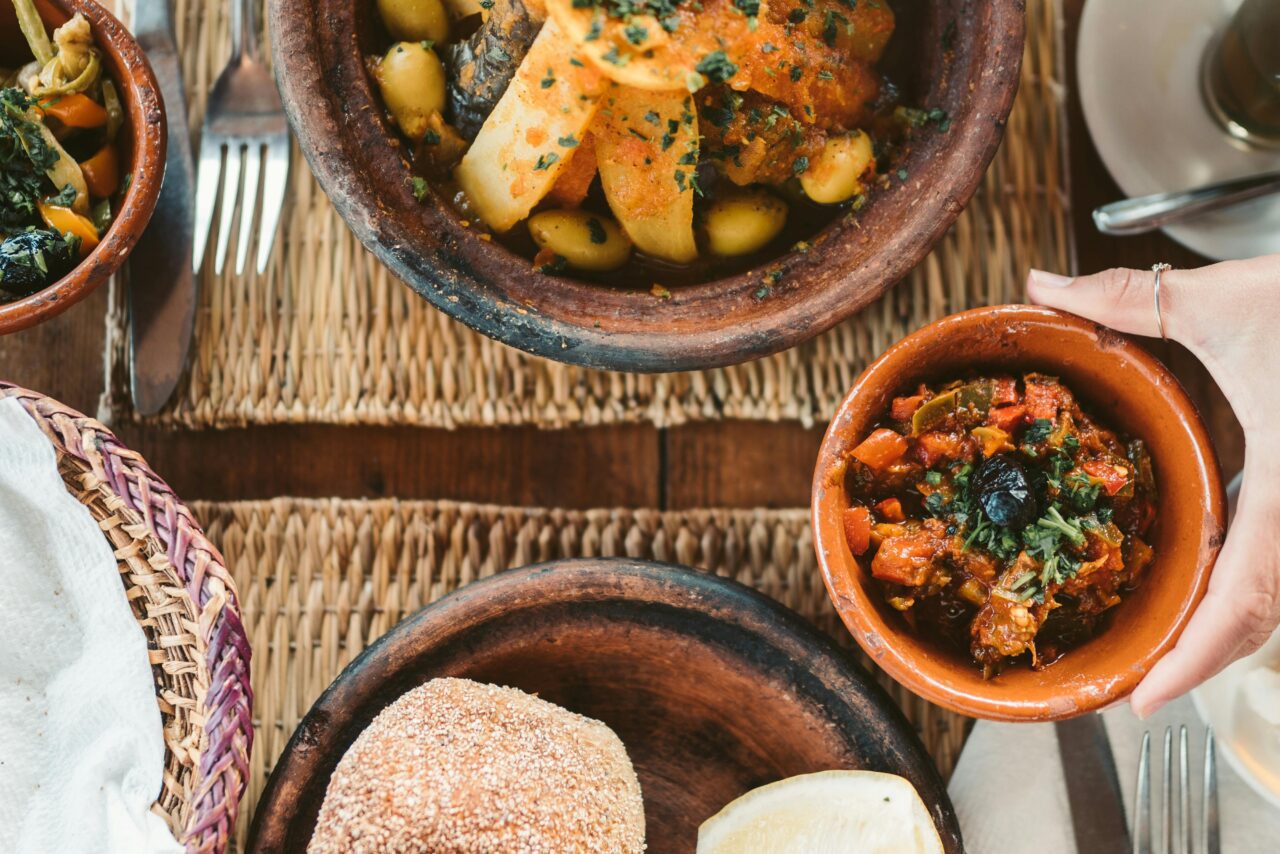
Moroccan Cuisine: A Rich Tapestry of Flavors and Traditions
Moroccan cuisine is a vibrant and diverse culinary tradition that reflects the country’s deep-rooted history and cultural influences. Known for its fragrant spices, slow-cooked stews, and flavorful dishes, Moroccan gastronomy is an intricate blend of Berber, Arab, Mediterranean, and French influences. Whether dining in a traditional riad, exploring the bustling souks, or enjoying a fine-dining experience, food in Morocco offers an unforgettable journey for the senses.
The Art of Spices: The Heart of Moroccan Cuisine
One of the most iconic aspects of Moroccan cuisine is its extensive use of spices. Saffron, cumin, cinnamon, ginger, paprika, and ras el hanout—a complex blend of various spices—are fundamental to the country’s culinary identity. Moroccan dishes delicately balance these flavors to create a harmony of sweet, savory, and aromatic notes. This distinct use of spices makes Moroccan fare not only delicious but also a unique representation of the country’s heritage.
– Key Spices:
– Saffron: Adds a golden hue and floral aroma to dishes like bouillabaisse and pastilla.
-Cumin: Provides earthy warmth to tagines and couscous.
– Ras el Hanout: A mysterious spice blend that varies by region, often including cardamom, coriander, and cloves.
Staple Dishes: Tagine and Couscous
A staple dish in Moroccan cuisine, tagine is a slow-cooked stew named after the earthenware pot used for cooking. It features lamb, chicken, beef, or vegetables, enhanced with olives, preserved lemons, dried fruits, and almonds. The slow-cooking process allows the ingredients to absorb the rich flavors, resulting in a dish that is tender, fragrant, and deeply satisfying. Another beloved dish is couscous, a staple in North African cuisine.
Traditionally served on Fridays, couscous is steamed semolina topped with vegetables, chickpeas, and slow-cooked meat, creating a hearty and nutritious meal.
– Tagine: Lamb, chicken, vegetables, olives, preserved lemons.
– Preparation: Slow-cooked in a clay pot to infuse flavors.
– Couscous: Steamed semolina grains, vegetables, chickpeas, and slow-cooked meat.
Street Food: Casual Delights in Morocco
Street food is another essential part of Moroccan cuisine, offering a more casual yet equally flavorful dining experience. Visitors to Morocco’s bustling markets and medinas will find an array of delicious street foods:
– Kefta Skewers: Grilled spiced meat skewers, often served with harira soup.
– Msemen: A layered Moroccan pancake, often enjoyed with honey or olive oil.
– Harira: A tomato-based soup, traditionally enjoyed during Ramadan.
– Bastilla: A savory-sweet pie made with layers of crispy pastry, spiced meat , almonds, and a dusting of powdered sugar and cinnamon.
Bread and Salads: Everyday Essentials
Bread plays a significant role in Moroccan food culture, serving as a staple at almost every meal. Various types of bread, including khobz , batbout , and harsha , accompany meals and are often used to scoop up stews, salads, and dips. Moroccan salads, both cooked and raw, are also an integral part of the dining experience. Zaalouk and taktouka are among the many vegetable-based dishes that add freshness and vibrancy to Moroccan meals.
– Khobz: A round, crusty bread often served with tagines.
– Zaalouk: A dip made from roasted eggplant and tomatoes, seasoned with cumin and garlic.
Sweet Treats: Indulgence with a Twist
Moroccan sweets and desserts highlight the country’s love for nuts, honey, and aromatic spices. Chebakia, a deep-fried sesame cookie coated in hone, while sellou, mix of roasted flour, almonds, and sesame seeds. Sweet Pastilla, a delicate dessert made with crispy layers of phyllo, milk, and almonds, is another indulgence that reflects Morocco’s pastry-making expertise. These sweets are typically enjoyed with a glass of Moroccan mint tea, a national beverage that is synonymous with hospitality and social gatherings.
– Chebakia: Deep-fried cookies coated in honey, popular during Ramadan.
– Sellou: A roasted flour mixture with nuts, perfect for snacking.
– Pastilla au Lait: Layers of phyllo dough filled with milk and almonds.
Tea Culture: More Than Just a Drink
In Moroccan society, tea culture is deeply rooted, and mint tea symbolizes warmth and generosity. To prepare it, green tea leaves are steeped with fresh mint and sweetened with generous amounts of sugar. Served in beautifully crafted glasses, Moroccan mint tea is a ritualistic experience that extends beyond mere refreshment; it is a moment of connection between friends, family, and visitors.
Ingredients: Green tea, fresh mint, sugar.
-Communal Dining: Sharing Is Caring
Moroccan cuisine is not only about taste but also about the experience of sharing food with others. Meals in Morocco are often communal, with large platters placed at the center of the table for guests to enjoy together. This tradition reflects the country’s strong sense of hospitality and community, making food an essential part of Moroccan culture and identity.
– Shared Plates: Large platters of tagines, couscous, and salads.
– Hospitality Food is a way to welcome and connect with others.
Evolving Moroccan Cuisine Beyond its traditional dishes, Moroccan culinary traditions continue to evolve, incorporating modern techniques and global influences. High-end restaurants in cities like Marrakech, Casablanca, and Rabat are redefining Moroccan dining, offering gourmet experiences that blend tradition with modernity.
– Innovative Dishes: Fusion of traditional flavors with international techniques.
– Fine Dining: High-end restaurants showcasing Moroccan cuisine with a modern twist.
To sum up , a Culinary Adventure in Morocco Exploring Moroccan cuisine is a sensory adventure that goes beyond taste it is about history, tradition, and the joy of sharing meals. The combination of spices, cooking techniques, and cultural traditions make Moroccan food one of the most captivating and cherished cuisines in the world .
 Contact : +212 618-688888
Contact : +212 618-688888




